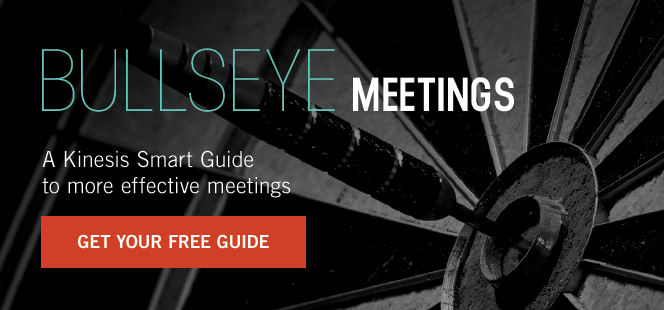‘The Spark’ is when business leaders stand right on the cusp of opportunity, but need a little extra oomph to move from inspiration to transformation. Keep an eye on the Kinesis blog for this new series.
Tired of ineffective meetings?
Try the Bullseye Meeting structure
Let’s face it. Some meetings are a complete waste of time.
We’ve all experienced this situation: having to stop mid-project to attend a meeting with people staring at their laptops or zoning out with eyes glazed over. It’s hard to imagine a bigger time suck than ineffective, non-productive meetings. And, it’s crazy how many the average employee will suffer through. Research shows that the average worker spends a whopping 31 hours a month on unproductive meetings.
The most common complaint about meetings? Too few of them lead to concrete outcomes. The next most cited grievance is that facilitators are poorly prepared and disorganized.
Here’s the good news: at Kinesis, we have developed a meeting structure that can end your pain. We call it the Bullseye Meeting.
If you follow this process, you’ll find that the results of your meetings improve immediately. Our entire team employs these methods each and every time in our weekly and monthly meetings – both internally and with clients.
The Bullseye Meeting structure will help you:
- Have productive meetings
- Stay on topic and on time
- Hold your team accountable
- Leave with actionable outcomes
Ready to learn how to put this plan into action? Let’s dive in!
How to hit the “Bullseye” every time
1. Set an agenda.
Never begin without a clear idea of what you will cover in the meeting. Make sure every attendee has a copy of the agenda. At Kinesis, the person running the meeting usually emails the agenda out or includes it in the calendar invite. Also, if you have any materials you plan to go through in the meeting, send these documents out with the agenda so your team can digest the content. As a meeting attendee, review the agenda and documents ahead of time and come prepared with thoughts and questions.
2. Determine a clear leader.
Typically, the person who convenes the meeting will put together the agenda. She or he will also lead it. Even if your meeting involves two or three people, have a clear lead. This results in the most effective process and outcomes.
3. Know the purpose of your meeting.
In the invitation to your meeting, state its purpose. When you convene, make sure the leader starts the session with the statement, “The purpose of this meeting is to {state desired outcome}.” This declaration serves to keep everyone on topic and focused on the results. If the conversation goes off topic, the leader should remind the group of the original purpose.
4. Start and end on time.
Your meeting leader is responsible for starting and ending the meeting on time. People who show up late affect everybody – the leader should start immediately and not wait for stragglers. If meetings chronically start five to 10 minutes late at your company, make every effort to reverse this trend.
5. Keep the agenda to fewer than five topics.
Better yet, make it only two or three items! Long agendas are daunting and it’s likely that your team won’t get everything accomplished. Set your meetings up for success each and every time by covering a limited amount of hyper-focused topics. Choose topics that affect all meeting attendees so you aren’t wasting anyone’s time.
6. Set a realistic time limit for each topic.
Let each topic dictate the time it needs in the agenda, but always keep to your time limit. If a discussion gets too hearty around a topic, then use your Parking Lot (see next item) as a place to capture anything out of scope. By setting a time limit, you help your team to adapt comments and input into the allotted time frame.
The meeting lead is responsible for ending the agenda item when its allocated time is up. If people are still talking, we like to use language such as, “Okay, I’m going to pause this discussion. I’m hearing many great ideas, but our time is up for the topic.” Then, let people know how and when the topic will be addressed.
7. Create a Parking Lot.
Part of the leader’s job during the meeting is to make sure the participants stay on topic and follow the agenda that she or he set. Sometimes, great ideas come out of a meeting. Other times, problems arise that need to be explored. However, if topics are outside of the scope of the meeting (whether positive or negative), they should be put in the “Parking Lot” for a separate meeting or discussion. You can keep a Parking Lot on the side of a whiteboard, on a flipchart paper, or in your meeting notes.
8. Take notes and send them out.
At every meeting, designate a note taker. This person could also be the leader if she or he is adept at leading and notetaking (this is a lot easier in a small group). For larger meetings, the leader may consider bringing in a support person who is at the meeting explicitly to capture discussion and next steps.
After the meeting, the note taker should polish and send out the notes. They do not have to be a transcription, but should capture the important points and be easy for group members to scan.
9. Clarify action items, assigned tasks, and due dates.
Every meeting should have documented next steps assigned in the meeting and captured in the notes. Next to each action item, agree on an assigned due date. If applicable, add these action items to the next meeting agenda for team members to report on their progress.
10. Measure, report, and update.
In every project-focused meeting, include a small amount of time to update the group on progress. This ensures implementation and accountability among meeting participants.
Set yourself up for success
Adapting the Bullseye Meeting structure as a company and as a department will help you improve communication, reduce wasted time, solve problems, and stay on track. You will turn those boring, unproductive meetings into powerful motivators that are integral to your business success!
Click here to download our in-depth, printable guide on creating more effective meetings with the Bullseye method!


